11 Best Data Analysis Courses for 2024: From Data to Insights
Become a Data Analyst with the best online courses from renowned institutions and universities.
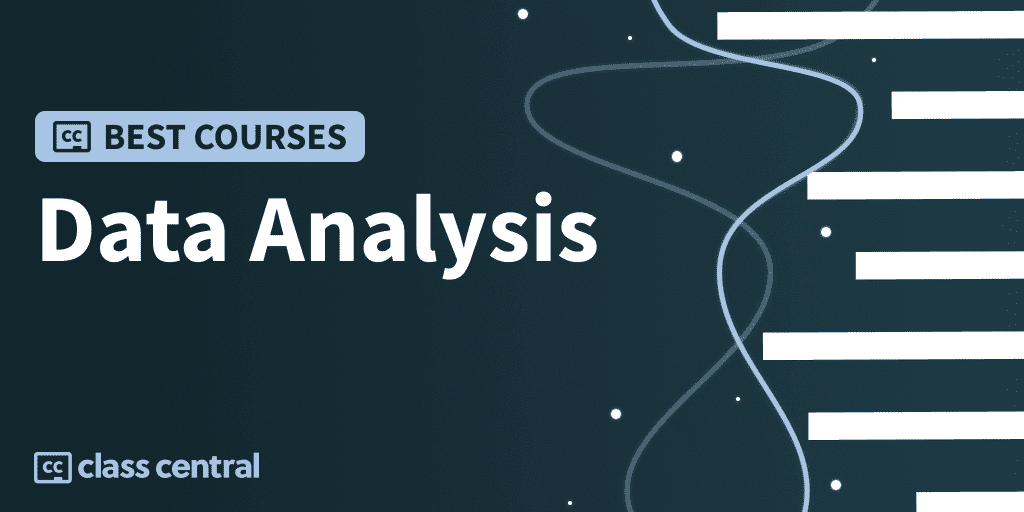
Ever heard the saying “Data is the new oil”?
In today’s world, data has indeed become a new kind of currency, driving everything from business decisions to medical research. But how do we make sense of this deluge of data?
Welcome to the realm of data analysis, a field that extracts meaning from raw data to support decision-making. This crucial skill has become the beating heart of successful businesses worldwide, an art form that turns mountains of numbers into coherent and actionable insights.
Yet, you don’t need to break the bank to master this valuable discipline! In this Best Courses Guide (BCG), I’ve compiled a list of the best data analysis courses around the web, ranging from courses by independent instructors, to universities and learning institutions, and even big name companies. Some of the courses here are free or free to audit, some are paid, and a small minority even come with free certification.
Click on the shortcuts for more details:
- Top Picks
- What is Data Analysis?
- Why You Should Trust Us
- Courses Overview
- How We Made Our Picks and Tested Them
Here are our top picks
Click to skip to the course details:
What is Data Analysis?
Data analysis, put simply, is the practice of extracting useful actionable insights from raw complex data.
For example, a data analyst working in a retail company could analyze sales data to identify which products are selling best, which are underperforming, and why. They might look at data from different regions or stores to see if there are variations in performance. These insights could help the company decide what products to stock more of and which ones to discontinue.
Or in an e-commerce company, they might examine customer behavior data to understand shopping patterns, which can then guide the businesses’ marketing strategies, website design, and product offerings.

This might sound simple, but reality is often disappointing. Most data that arrives at the data analyst’s doorstep is dirty. Thus, data analysts have to clean and organize the data into an analyzable state. And that’s if the data isn’t flawed or biased!
Thus, data analysts use a variety of tools for their workflow, not only to help them clean and analyze data but to also present it to other less data-inclined fellows. Some of the most commonly used ones are:
- Spreadsheets: Applications like Microsoft Excel are commonly used for basic data analysis tasks.
- SQL: Many data analysts use SQL to retrieve, manipulate, and analyze data stored in relational databases.
- Statistical Software: Tools such as R and SAS offer advanced statistical analysis capabilities.
- Data Visualization Software: Tableau, and PowerBI make it easy for analysts to create visually appealing and interactive dashboards.
- A programming language like Python, R, or Julia: Sometimes, data analysts need more flexibility and power than what traditional tools can offer. That’s where programming languages come in. You can handle large datasets, perform complex statistical analyses, develop machine learning models, automate repetitive tasks, create custom data visualizations, and more.
By the way, the links above lead to their respective BCG subjects. So if you want to learn each topic in more detail, check them out.
What’s the difference between Data Analysis and Data Science?
Data analysis and data science are two terms often used interchangeably. However, they represent different, albeit interrelated, fields.
Data analysis is a component of data science. It is more descriptive than prescriptive, as it focuses on interpreting the results and uncovering patterns to aid decision-making.
On the other hand, data science is more broad and prescriptive. Data scientists might do the same work as data analysts, but often use machine learning algorithms to predict future trends based on current data. If you want to know more about data science, check out my data science BCG.
Why become a data analyst?
Data analysts are in high demand in more places than you think! They are needed in a diverse range of fields, including healthcare, finance, marketing, technology. That’s the reason why the U.S. Bureau of Labor Statistics projects that the demand for data science and analytical skills will grow by 28% by 2026.
And with high demand comes attractive salaries! According to Glassdoor, as of 2024, the average total pay for data analysts in the United States is approximately $84,000 per year.
Why You Should Trust Us
Class Central, a Tripadvisor for online education, has helped 60 million learners find their next course. We’ve been combing through online education for more than a decade to aggregate a catalog of 200,000 online courses and 200,000 reviews written by our users. And we’re online learners ourselves: combined, the Class Central team has completed over 400 online courses, including online degrees.
Courses Overview
- Eight of the courses in this ranking are free or free-to-audit while the other three are paid
- Only one course in this ranking isn’t suitable for beginners, the rest are beginner-friendly.
Best Free University-Level Python Course for Programmers (University of Helsinki)
Another banger course from the University of Helsinki, this Data Analysis with Python course is the best undergraduate-level course for new-to-Python programmers looking to dive head-first into the world of data.
Why? Because this text-based course not only covers essential concepts like data cleaning, data wrangling, data visualization, and even a dash of machine learning, but it also comes with tons of machine-graded hands-on coding exercises to solidify your NumPy, pandas, and matplotlib coding skills. And to top it all off, you’ll complete one of three peer-reviewed capstone projects where you’ll analyze a dataset, explain the data you have, and make predictions of new data. This is a great opportunity for putting into practice all that you’ve learned so far.
No knowledge of Python is needed to take this course, though you are expected to have programmed before. Additionally, you’ll need to put in a lot of work; the course is 7 weeks long and each week has about 5 to 20 hours of lessons and exercises to complete.
Unfortunately, unlike Helsinki’s other courses, it isn’t easy to get a certificate. You’d need to register your credits in their study register and then request an official transcript of records. However, the course does have an official Discord server run by instructors and volunteers for learners to ask questions.
| Institution | University of Helsinki |
| Provider | mooc.fi |
| Level | Beginner |
| Workload | 35–140 hours |
| Cost | Free |
| Exercises | Available |
| Certificate | Free, if ECTS credits are registered |
Best Python Course with Free Certificate for Programmers (freeCodeCamp)
Perhaps you’re disappointed by the difficulty of getting a certificate from the previous course. Well fear not, for we have freeCodeCamp!
This Data Analysis with Python course is just as extensive as Helsinki’s course, minus the machine learning topics. By the end of this certification, you’ll know how to read data from sources like CSVs and SQL, and how to use libraries like Numpy, Pandas, Matplotlib, and Seaborn to process and visualize data.
You’ll learn primarily from watching the videos lessons / video walkthroughs, and answering the MCQ questions to test whether you’ve been paying attention.
Of course, any certification-available course must come with projects to prove the worthy. There are a total of five projects that you must complete, of which you’ll:
- Calculate mean, variance, and standard deviation for a 3×3 matrix using NumPy.
- Explore races, education, and salaries in a 1994 census dataset with pandas.
- Plot cardiac health and lifestyle factors statistics with pandas, matplotlib, and Seaborn.
- Analyze and describe page views from 2016 to 2019 using pandas, matplotlib, and Seaborn
- Predict global sea level rise from historical data with pandas and matplotlib.
You should have some experience with the Python programming language. For example, you’ve taken the prerequisite course Scientific Computing with Python.
| Institution | freeCodeCamp |
| Level | Beginner |
| Workload | 300 hours |
| Rating | 4.8 / 5.0 (16) |
| Certificate | Free |
Best Data Analytics Certificate with Live Sessions and Mentoring (Noble Desktop)
If you prefer instructor-led learning, Noble Desktop’s Data Analytics Certificate offers real-time feedback and accountability that pre-recorded courses can’t match. And you’ll earn a NY State-Licensed Certificate.
What I find interesting is that this program runs both in-person (NYC campus) and online (Zoom). Even if you’re attending online, you’ll have individual attention and can see other students in the classroom. You’ll be able to interact with instructors, receive feedback, and ask questions during sessions. Plus, you’ll get access to class recordings and workbooks – pretty helpful for catching up if you miss a class or reviewing what you learned.
Key Benefits
- Small class sizes (8-15 students)
- Free retake within one year
- Detailed class files with real-world projects
- Supplemental after-class projects and video suite
- Earn a NY State-Licensed Certificate.
Noble Desktop knows what they’re doing – they’ve been around for over three decades providing instruction with industry experts. So you can rest assured your mentorship will not be with someone who just finished the course. Don’t take my word for it – student reviews on Yelp and Google praise their practical approach and instructor quality.
What You’ll Learn
- Advanced Excel techniques for manipulating and visualizing data
- To use Tableau to create persuasive, easy-to-use interactive dashboards
- To gather, clean, analyze, and visualize data with the Python programming language
- To extract information using SQL to interact with relational databases and perform database operations
- To work with machine learning algorithms and artificial intelligence applications
- Interpret the results in an accurate and meaningful way using advanced techniques and statistical tools.
Flexible Schedule Options
- 6 weeks full-time (weekdays)
- 24 weeks part-time (evenings).
“It was great to see my progress during the duration of this bootcamp. I started with no prior knowledge of Python and by the end of the course, I was able to complete a machine learning project using Python.” – Niekel Griffith, Noble Desktop learner.
| Provider | Noble Desktop |
| Instructors | Art Yudin, Brian McClain, Garfield Stinvil, Mourad Kattan |
| Level | Beginner |
| Workload | 156 hours (plus optional 30-hour Python for AI elective) |
| Rating | 4.8/5.0 (Yelp) and 5.0/5.0 (Google) |
| Exercises | Real-world projects |
| Certificate | Paid |
Best Free-to-Audit Course for Beginners with Professional Certificate (Google)
Are you a complete beginner willing to spend cash on a high-quality course and get a professional certificate from Google? If so, then read on!
The 6 months long Google Data Analytics Certification programme (also available in French) is one of the most highly-rated (4.8 / 5.0) and popular (2.3M learners) courses for aspiring data analysts out there — and for good reason. It offers a complete and comprehensive curriculum on both the data side (how to do) and the business side (what to do) of the job.
To give a brief overview of what you’ll learn from the course, you’ll:
- Understand what data analysis means and what a data analyst
- Collect raw data with SQL and spreadsheets
- Prepare data for analysis by cleaning and organizing raw data.
- Gather hidden insights from data through complex data calculations.
- Share what you found to your non-data analyst partners with data visualization tools like Tableau.
- Program in the R programming language using the Tidyverse package, one of the top 5 most widely used packages, for data analysis.
- And finally, complete a capstone project which puts together all you’ve learned so far to solve a case study of your choice.
The individual courses are actually free-to-audit. This means that you can view the learning materials, however you won’t have access to any graded quizzes, exercises or coding labs.
| Institution | |
| Provider | Coursera |
| Level | Beginner |
| Workload | 260 hours |
| Enrollments | 2.3M |
| Rating | 4.8 / 5.0 (141K) |
| Cost | Free-to-Audit |
| Exercises | Available |
| Certificate | Paid |
Best Free Data Analyst Bootcamp for Beginners (Alex The Analyst)
If you’re just like me and prefer to invest as little money as possible to learn new things from scratch, I have a course just for you: Alex’s free data analyst bootcamp.
As to why this is called a bootcamp, it’s a bit satirical. Alex saw bootcamps charging exorbitant prices to teach you something you can find on the web for free, and so decided to do the opposite.
This bootcamp is as wholly comprehensive as Google’s course. It doesn’t only cover one language or one topic — it teaches you the all necessary skills required for a data analyst. That means you’ll focus on four main topics in this course:
- SQL: Relational databases are the primary way businesses store data. But how do you get the data you need, into the way you want it? That’s what SQL is for.
- Excel: Excel know-how is basically assumed from you by every company. You’ll be able to go through the entire data analyst workflow in Excel.
- Tableau / Power BI: Data visualization helps get your insights across to your boss or co-workers without them needing a Bachelors in Mathematics to understand it. You’ll learn how to use these popular business intelligence tools.
- Python: You’ll use Python to do all sorts of nitty-gritty tasks that the other tools mentioned above can’t handle, from data cleaning to data visualization.
And did I forget to mention that you’ll be completing real-world projects at the end of each topic for you to put on your portfolio? Oh yes there is!
You can also obtain a free certification (not verified) stating that you’ve completed the boot camp by following instructions in the last video.
| Channel | Alex The Analyst |
| Provider | YouTube |
| Instructor | Alex Freberg |
| Level | Beginner |
| Workload | 19–20 hours |
| Views | 6.2M |
| Cost | Free |
| Exercises | Available |
| Certificate | Free (but not verified) |
Best Free University-Level R Course for Beginners (MIT)
Moneyball, eHarmony, the Framingham Heart Study, Twitter, IBM Watson, and Netflix —what do all of these have in common? They are all prime examples of how data science and analytics have transformed and revolutionized the business world.
Do you want to learn the analytical secrets behind their success? The Analytics Edge from MIT will certainly indulge you.
This free course is one of the best courses to take if you want a rigorous understanding of both analytical methods and R programming. It is challenging and does require a background in basic statistics and optimization, but you’ll find that the time taken will truly be worth it.
Through many lectures, quick questions, and exercises, you’ll not only understand many different analytics methods (regression, optimization, text analytics, clustering, data visualization, and more) but also be able to apply and implement them in R!
To enroll in this course you should have taken 15.060 Data, Models, and Decisions or an equivalent basic statistics and a basic optimization course (probability distributions, regression, nonlinear/discrete optimization).
An in-depth review of this course can be found in this article by a learner.
Note about the course:
There are two ways to take this course: on edX or on MIT OpenCourseWare. The course on edX is archived, meaning that you can view most of the course materials, such as lectures and readings for free, but you cannot complete assignments for a grade. I recommend that you take the course on MIT OpenCourseWare, as it has the same content as edX’s but with a much easier-to-use interface.
| Institution | Massachusetts Institute of Technology |
| Providers | edX / Mit OpenCourseWare |
| Instructor | Dimitris Bertsimas |
| Level | Intermediate |
| Workload | 130—195 hours |
| Rating | 4.6 / 5.0 (80) |
| Cost | Free |
| Exercises | Available |
| Certificate | None |
Best Free-to-Audit Python Course for Beginners (Jovian)
Jovian’s Data Analysis with Python: Zero to Pandas is an excellent beginner-friendly free-to-audit course that requires no prior knowledge of programming or data science whatsoever.
The main way you’ll learn in this course is through Jupyter notebooks — a user-friendly interactive platform that allows you to write, run, and visualize code, making learning Python and data analysis easy and enjoyable.
By the end of this course you’ll be a confident Python programmer and be able to use popular data science libraries like NumPy, pandas, and matplotlib for statistical computing, data processing, creating beautiful visualizations, and much more.
You’ll also get access to the course community forum and the Whatsapp group where you can ask questions, join a study group and share what you’re working on during the course.
And for those paying for the certificate, you’ll get the chance to practice and improve your skills with weekly assignments and finally, work on an end-to-end course project where you will perform data analysis on a large real-world dataset.
Aakash, the instructor (and co-founder of Jovian), has a full video walkthrough of the entire course on the freeCodeCamp YouTube channel, which is also available in Hindi.
| Institution | Jovian |
| Instructor | Aakash N S |
| Level | Beginner |
| Workload | 48–60 hours |
| Enrollments | 106K |
| Cost | Free-to-Audit |
| Exercises | Available |
| Certificate | Paid |
Best Job-Ready Python Course with Professional Certificate for Beginners (DataCamp)
DataCamp stands as one of the best premium online platforms on data science and analysis. And this Python career track (there’s also an R track) will provide you with all the essential knowledge and skills to kickstart a successful career in the field of data science — from scratch!
This career track comprises 9 courses, each spanning 4 hours:
- Introduction to Python
- Intermediate Python
- Data Manipulation with pandas
- Joining Data with pandas
- Introduction to Statistics in Python
- Introduction to Data Visualization with Seaborn
- Exploratory Data Analysis in Python
- Sampling in Python
- Hypothesis Testing in Python
Your data analyst training begins with some of the most popular Python libraries, including pandas, NumPy, Seaborn, and many more. These libraries will teach you how to manipulate and visualize data.
Statistical methods like exploratory data analysis, sampling, and hypothesis testing form an integral part of any data scientist’s toolbox. Thus, you’ll also pick up these skills, knowing when and how best to use them.
And my favorite thing about DataCamp is that you’ll learn all of these topics in an interactive way. You’ll have access to an in-browser coding environment where you’ll watch lecture videos, complete coding exercises with real-world data sets, and answer MCQ questions. There’s also skill assessments along the way which quizzes you on what you’ve learned. Complete all of them and you’ll get a professional certificate from DataCamp.
DataCamp also offers learners with prior knowledge a personalized learning plan, if you don’t want to start the career track from scratch.
| Provider | DataCamp |
| Instructors | Hugo Bowne-Anderson, Richie Cotton, Maggie Matsui, Aaren Stubberfield, George Boorman, Izzy Weber, James Chapman |
| Level | Beginner |
| Workload | 36 hours |
| Cost | Paid |
| Enrollments | 65K |
| Exercises | Available |
| Certificate | Paid |
Best Free Platform to Practice Python Data Analysis Skills (DataWars)
Without regular practice, your data analysis skills can grow rusty. DataWars, however, offers a solution: fun, free Python puzzles and micro data analysis projects to keep your skills sharp.
DataWars is a platform 100% focused on practicing data science and applying your skills on real-life projects by working on bite-sized activities. The difficulty of the projects ranges from Easy to Advanced, making it suitable for all levels of programmers.
And to guide you on your DataWars journey, is the founder Santiago Basulto. In the Pandas & Python for Data Analysis by Example course, you’ll solve various projects, brainstorming and discussing the solutions and the pitfalls along the way. The course specifically covers using pandas for data analysis, data cleaning and data wrangling. You are encouraged to try to solve the projects by yourself first before revealing the video solutions.
Data Analysis nor pandas aren’t the only subject DataWars has to offer, though! They cover all the topics a data scientist or analyst should know: Machine Learning, Databases, Math and Statistics, and Visualization (not out yet by time of writing).
| Institution | DataWars |
| Channel | freeCodeCamp |
| Provider | YouTube |
| Instructor | Santiago Basulto |
| Level | All levels |
| Workload | 5 hours |
| Enrollments | 375K |
| Cost | Free |
| Exercises | Available |
| Certificate | None |
Best Free Excel / PowerBI course for Beginners (ExcelIsFun)
Some snobs may scoff at the thought of using Excel for data analysis, but most businesses (especially small ones) don’t care what tool you use as long as you can get results. And Excel can certainly be a powerful tool once mastered!
This free Data Analysis Course covers data analysis formulas, pivot tables, visualizing in Excel, the amazing Power Query, data modeling (yes, big data using Power Pivot), and even Power BI Desktop to create your reports and dashboards. And the best part of all is that zero data analysis knowledge is required — you’ll learn it throughout the course!
What I love about this channel is that Mike always provides PDF summaries and homeworks to complete after each lesson, which you can find here. These are very helpful especially when you’re just starting out. Even if you’re not going to use Excel for data analysis, I still recommend that you take this course as Excel know-how is usually assumed in most companies!
| Channel | ExcelIsFun |
| Provider | YouTube |
| Instructor | Mike Girvin |
| Level | Beginner |
| Workload | 5–6 hours |
| Enrollments | 340K |
| Cost | Free |
| Exercises | Available |
| Certificate | None |
Best Julia Resource for Programmers (Manning)
Are you a data analyst with experience in R or Python open to exploring faster and more expressive languages built with data science and analysis in mind?
Julia is a high-level dynamic programming language that ‘runs like C, but reads like Python’. Julia and R, unlike Python, were designed for Data Scientists. But unlike both Python and R, Julia is super fast . Check out my BCG on Julia if you are curious about the language.

In this paid book, you’ll learn how to use the Julia language to perform tasks that data scientists need to do routinely: reading and writing data in different formats, as well as transforming, visualizing, and analyzing it. But that’s not all Julia can do: you’ll also harness Julia’s multithreading potential to build a robust web service suitable for real-world customer needs!
The book also comes with exercises sprinkled around for you to practice what you’ve learned, along with solutions.
(In fact you can read this fantastic review of the book here)
| Publisher | Manning |
| Author | Bogumił Kamiński |
| Level | Beginner |
| Workload | N/A |
| Cost | Paid |
| Exercises | Available |
| Certificate | None |
How We Made Our Picks and Tested Them
I built this guide following the now tried-and-tested methodology used in previous Best Courses Guides (you can find them all here). It involves a three-step process:
- Research: I started by leveraging Class Central’s database. Then, I made a preliminary selection of 6900+ Data Analysis courses by rating, reviews, and bookmarks.
- Evaluate: I read through reviews on Class Central, Reddit, and course providers to understand what other learners thought about each course and combined it with my own experience as a learner.
- Select: Well-made courses were picked if they presented valuable and engaging content and fit in a set of criteria: comprehensive curriculum, affordability, release date, ratings and enrollments.
Fabio revised the research and the latest version of this article.

Elham Nazif



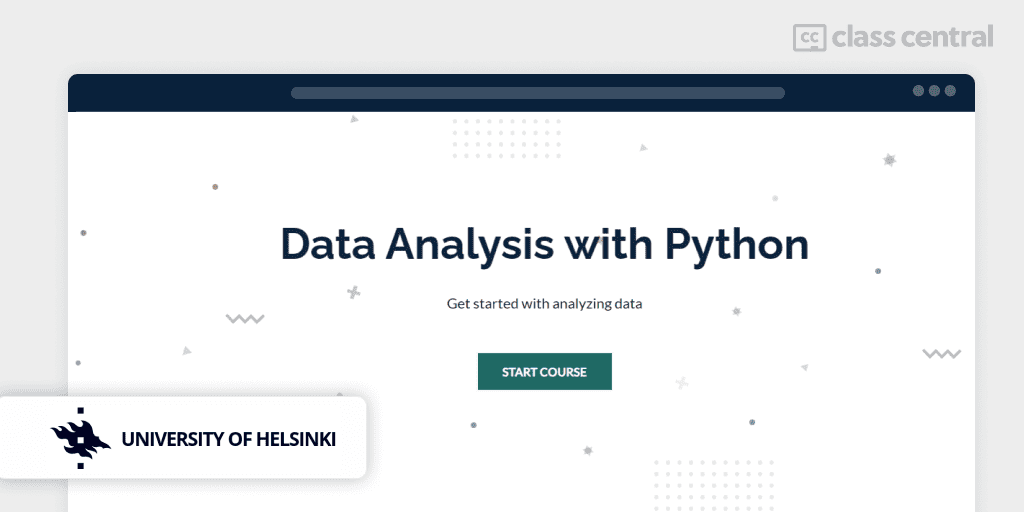
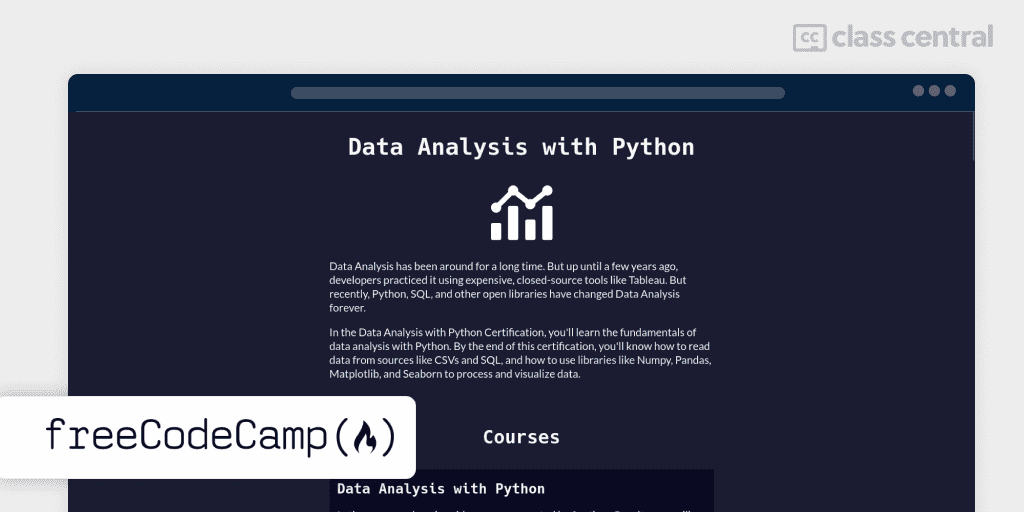



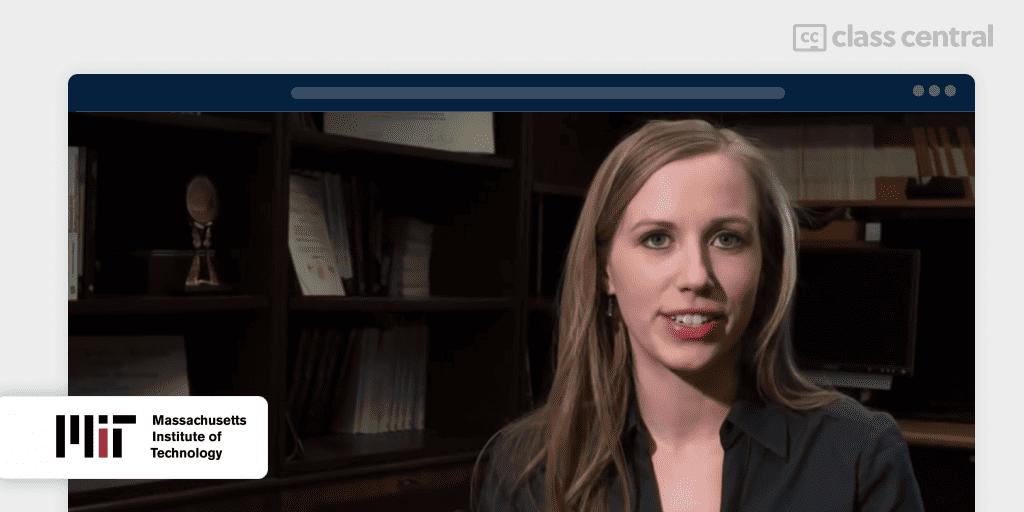
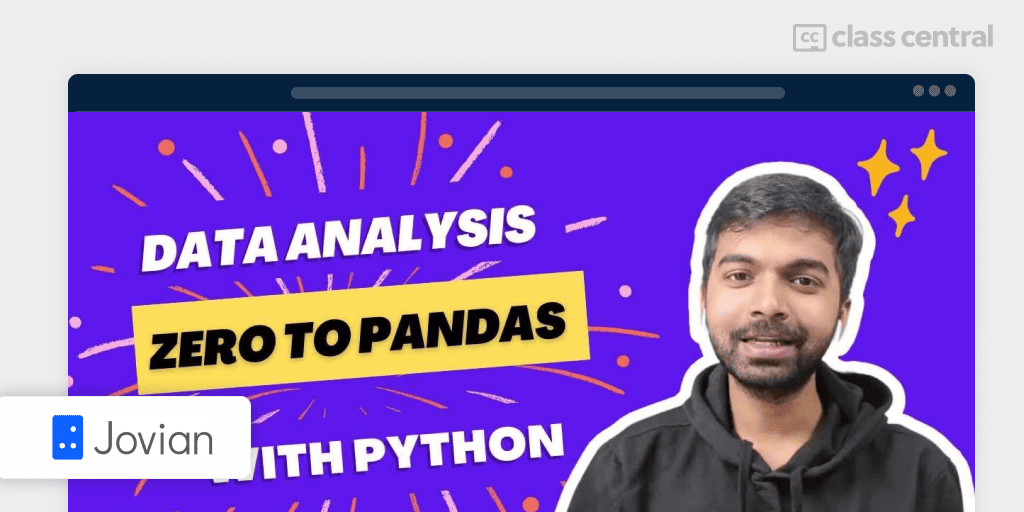
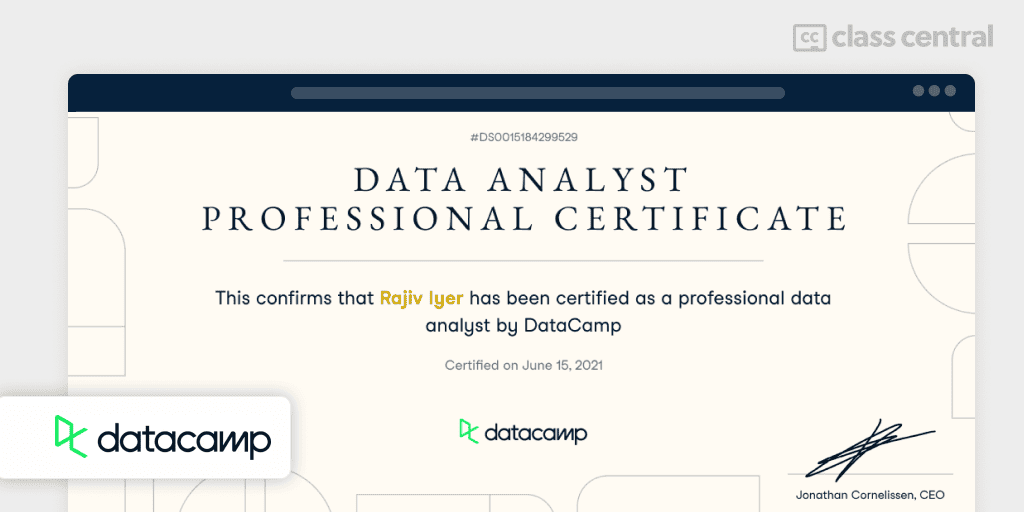

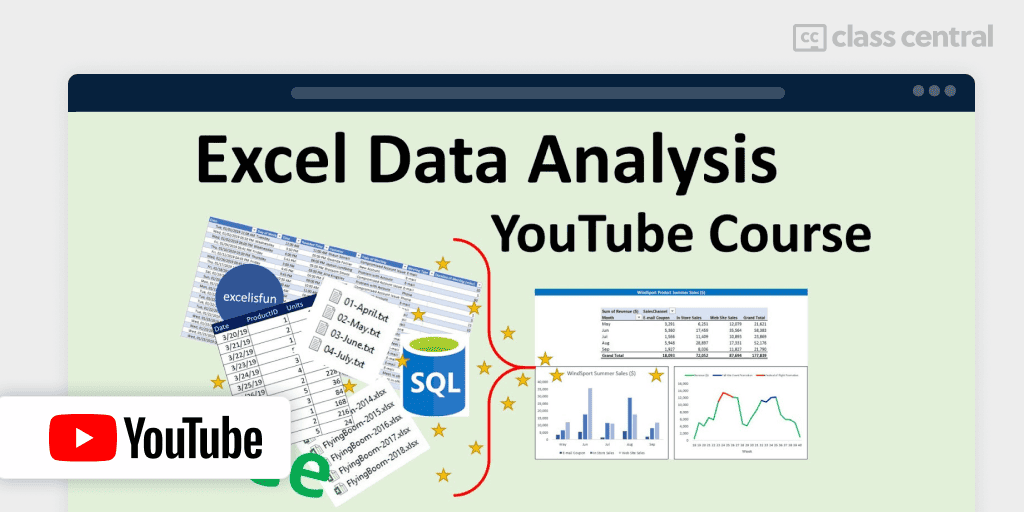
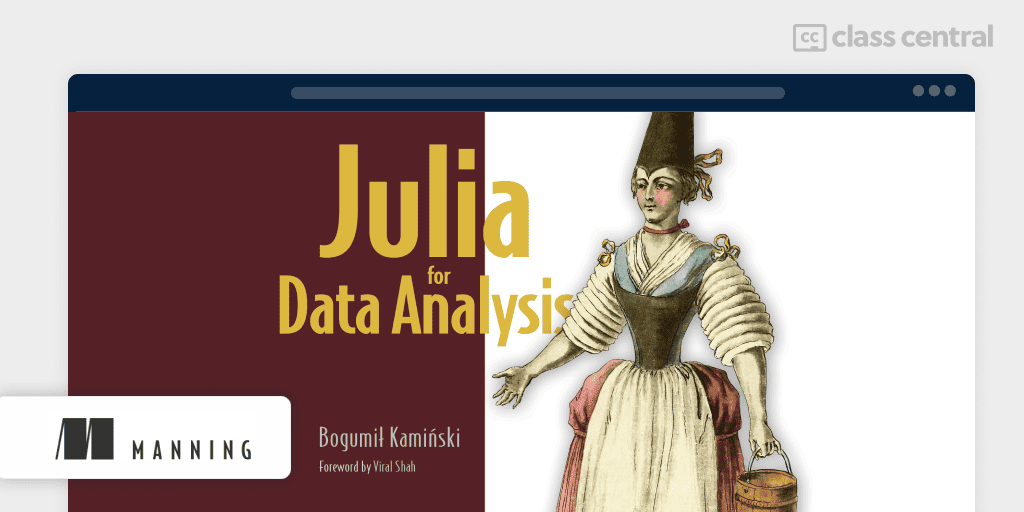
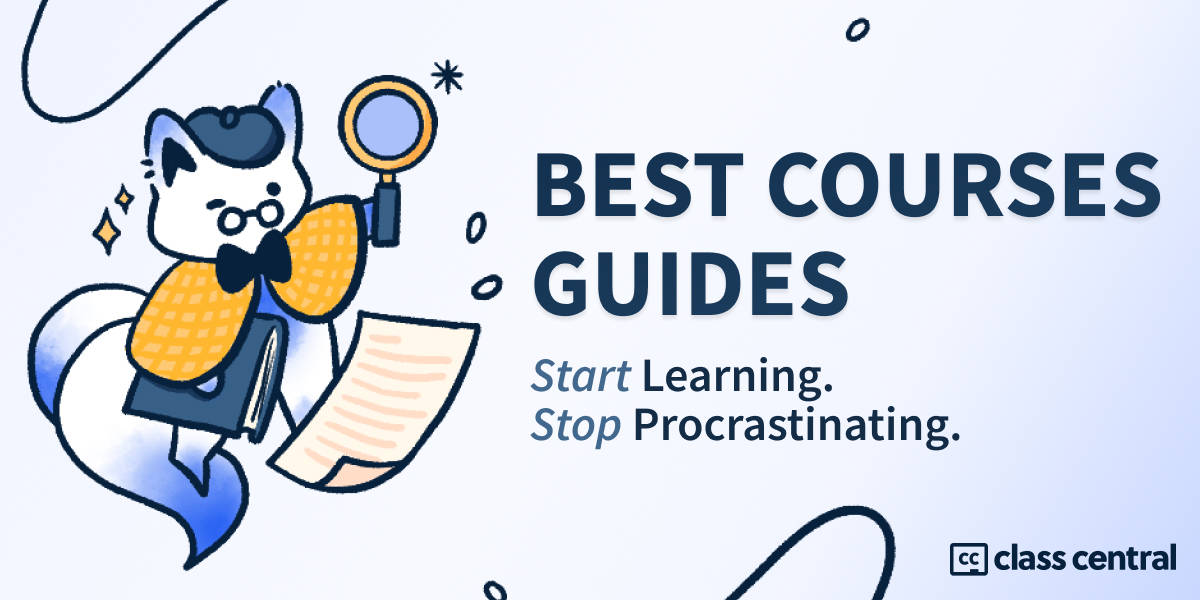






Alok Kumar
The Data Analysis course from the University of Helsinki now provides a certificate of completion.